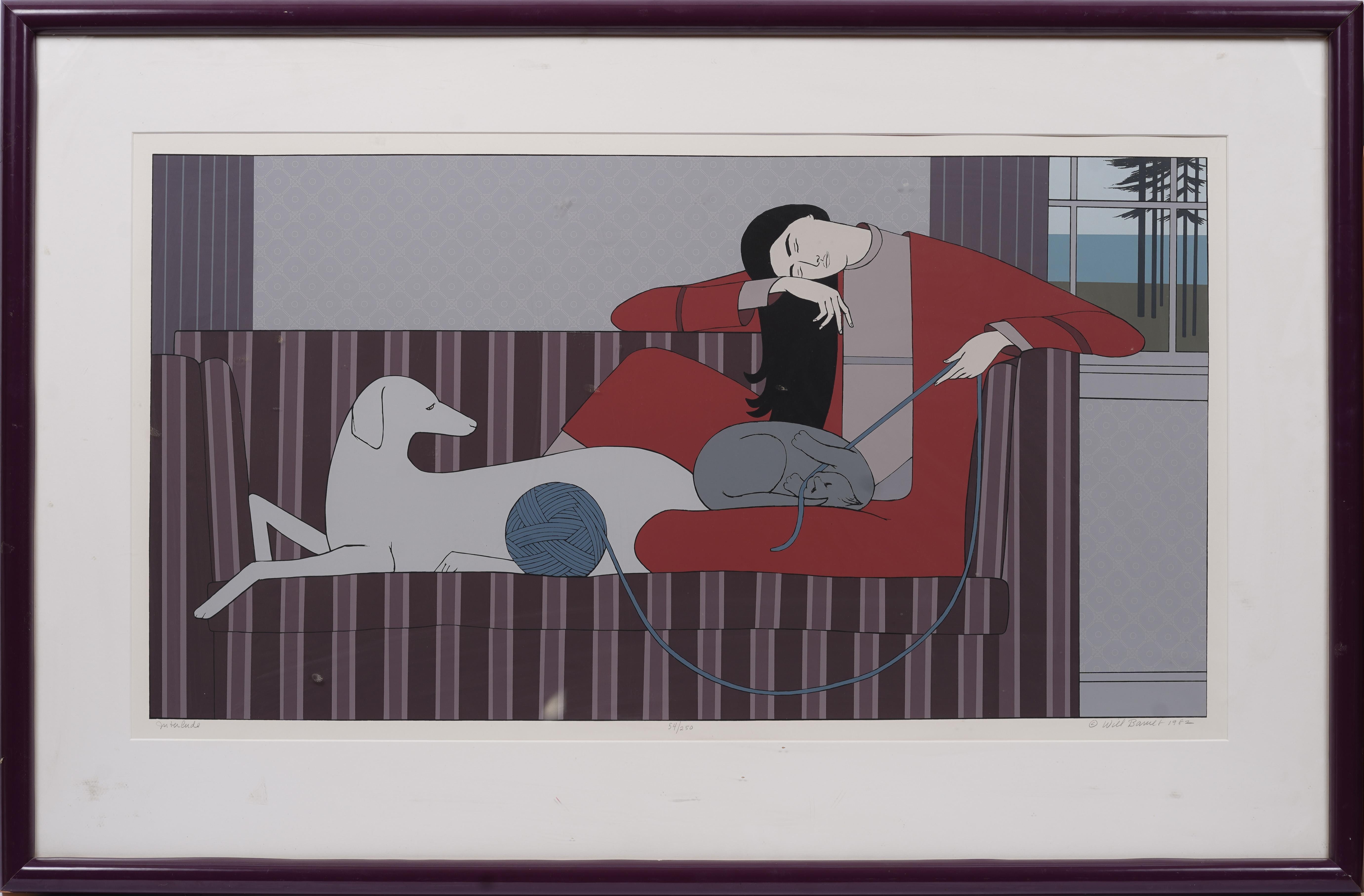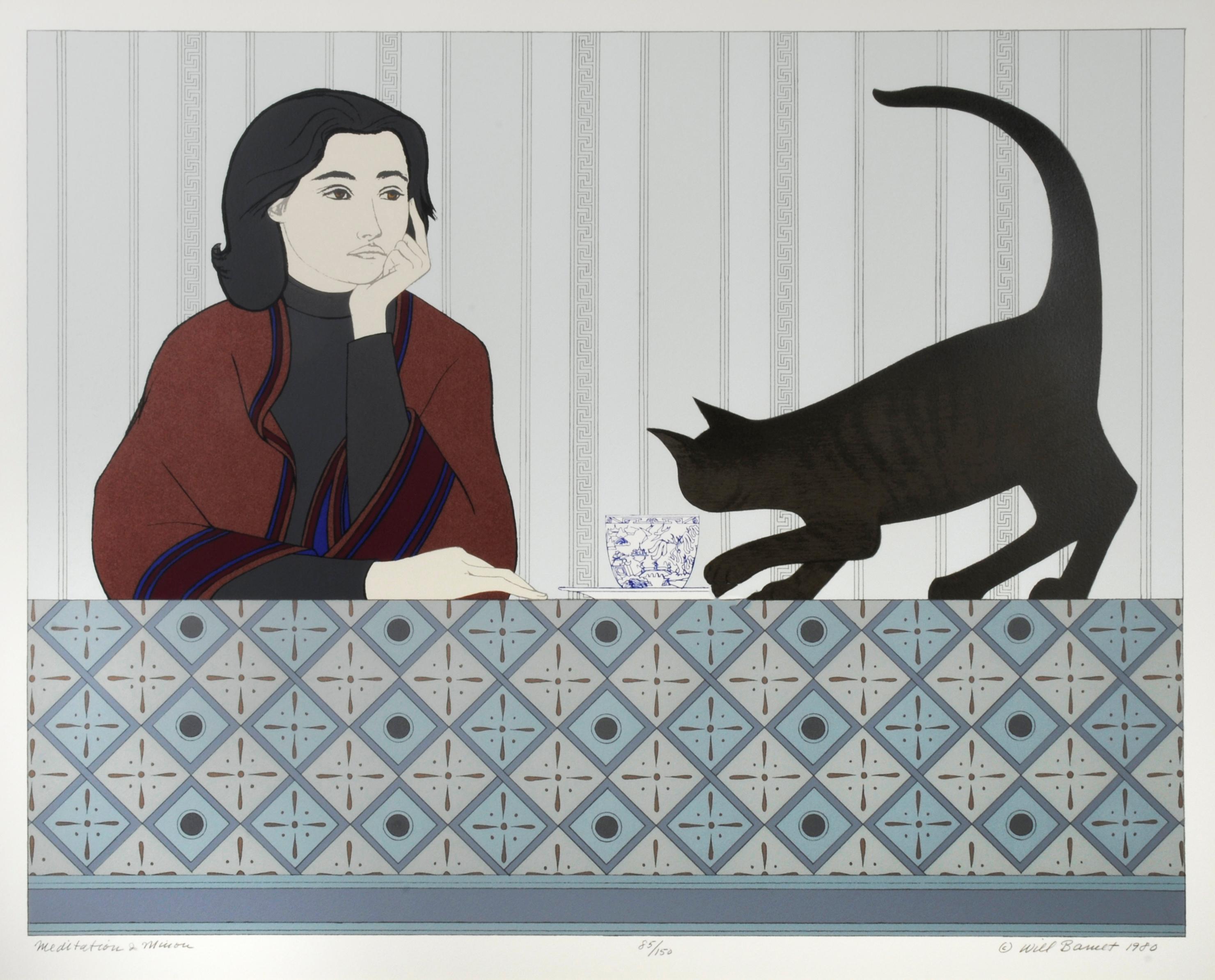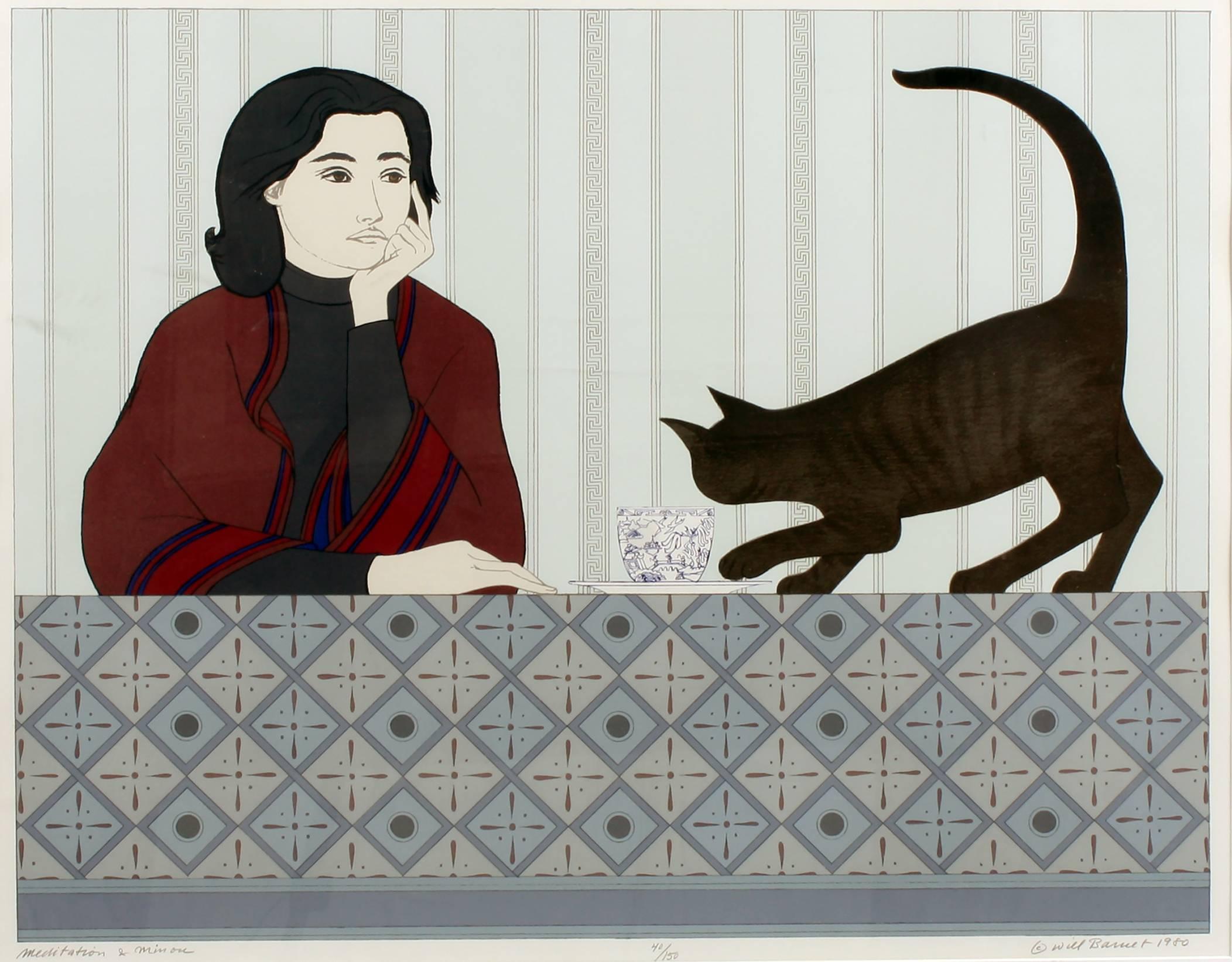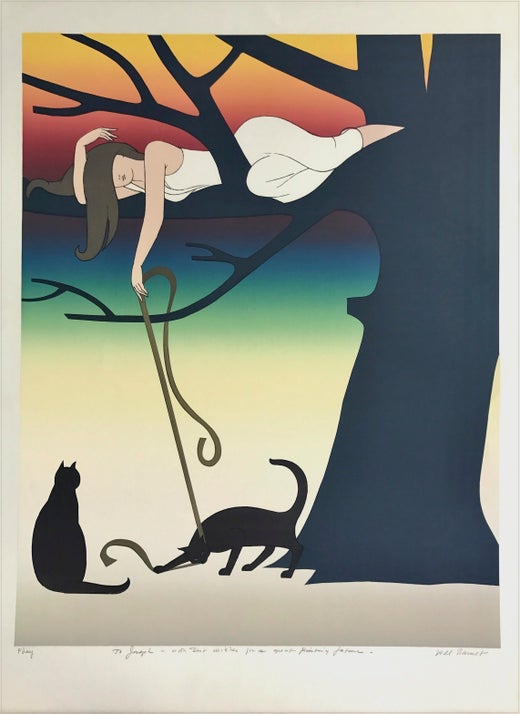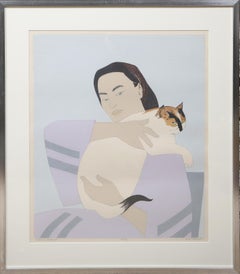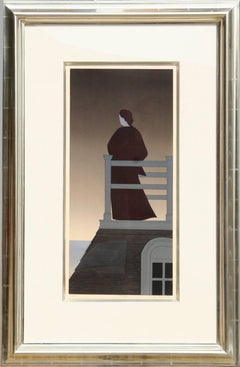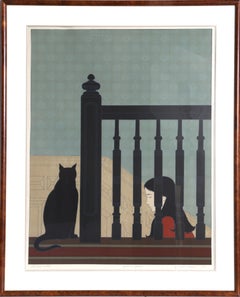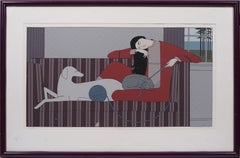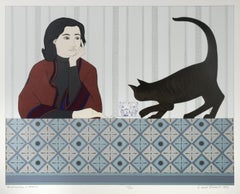Items Similar to Interlude, Screenprint by Will Barnet
Want more images or videos?
Request additional images or videos from the seller
1 of 7
Will BarnetInterlude, Screenprint by Will Barnet1982
1982
$2,850
£2,231.74
€2,529.85
CA$4,101.98
A$4,477.86
CHF 2,353.38
MX$54,324.17
NOK 29,676.59
SEK 27,833.68
DKK 18,885.79
About the Item
Artist: Will Barnet, American (1911 - 2012)
Title: Interlude
Year: 1982
Medium: Serigraph, signed and numbered in pencil
Edition: AP
Image Size: 20 x 38 inches
Size: 25.5 x 42.5 in. (64.77 x 107.95 cm)
Fig 179, pg 70 from Will Barnet: Prints 1931-2005, published by John Szoke Editions
- Creator:Will Barnet (1911, American)
- Creation Year:1982
- Dimensions:Height: 25.5 in (64.77 cm)Width: 42.5 in (107.95 cm)
- Medium:
- Movement & Style:
- Period:
- Framing:Framing Options Available
- Condition:In very good condition.
- Gallery Location:Long Island City, NY
- Reference Number:1stDibs: LU46610584742
Will Barnet
At the beginning of his career, Will Barnet was known for his figural depictions of domestic scenes. But, as he continued to stylistically develop, Barnet arrived at abstract geometric paintings far removed from his original career. A part of the Indian Space Painters group, Barnet was inspired by Native American art in creating these divergent images. Throughout his career, Barnet oscillated between representational and abstract paintings, never fully settling on one. He has received the National Medal of Arts in 2011, and his work has been displayed at the Whitney Museum of American Art, the Museum of Modern Art, and the Metropolitan Museum of Art.
About the Seller
4.9
Platinum Seller
Premium sellers with a 4.7+ rating and 24-hour response times
Established in 1979
1stDibs seller since 2014
3,155 sales on 1stDibs
Typical response time: 1 hour
- ShippingRetrieving quote...Shipping from: Long Island City, NY
- Return Policy
Authenticity Guarantee
In the unlikely event there’s an issue with an item’s authenticity, contact us within 1 year for a full refund. DetailsMoney-Back Guarantee
If your item is not as described, is damaged in transit, or does not arrive, contact us within 7 days for a full refund. Details24-Hour Cancellation
You have a 24-hour grace period in which to reconsider your purchase, with no questions asked.Vetted Professional Sellers
Our world-class sellers must adhere to strict standards for service and quality, maintaining the integrity of our listings.Price-Match Guarantee
If you find that a seller listed the same item for a lower price elsewhere, we’ll match it.Trusted Global Delivery
Our best-in-class carrier network provides specialized shipping options worldwide, including custom delivery.More From This Seller
View AllThe Cat, Signed Modern Screenprint by Will Barnet
By Will Barnet
Located in Long Island City, NY
Artist: Will Barnet, American (1911 - 2012)
Title: The Cat
Year: 1997
Medium: Screenprint on Arches, signed in pencil
Edition: AP
Image Size: 16 x 7 inches
Siz...
Category
1990s American Modern Figurative Prints
Materials
Screen
Woman and White Cat, Framed and Signed Modern Screenprint by Will Barnet
By Will Barnet
Located in Long Island City, NY
Woman and White Cat
Will Barnet, American (1911–2012)
Date: 1971
Screenprint, signed, titled and numbered in pencil
Edition of 45/200
Image Size: 23.25 x 20 inches
Size: 26 x 22 in. ...
Category
1970s American Modern Figurative Prints
Materials
Screen
Dawn, American Realist Lithograph by Will Barnet
By Will Barnet
Located in Long Island City, NY
Artist: Will Barnet, American (1911 - 2012)
Title: Dawn
Year: 1975
Medium: Lithograph on Arches, signed in pencil
Edition: 59/175
Image Size: 24 x 11 in.
Frame Size: 36 x 25 inches
...
Category
1970s American Realist Figurative Prints
Materials
Lithograph
The Bannister, Framed Modern Lithograph by Will Barnet 1981
By Will Barnet
Located in Long Island City, NY
Artist: Will Barnet, American (1911 - 2012)
Title: The Bannister
Year: 1981
Medium: Lithograph on Arches, signed and numbered in pencil
Edition: 300 (Art...
Category
1980s Contemporary Interior Prints
Materials
Lithograph
Waiting, Pop Art Framed Offset Print by Will Barnet
By Will Barnet
Located in Long Island City, NY
Waiting from the Kent Bicentennial Portfolio
Will Barnet, American (1911–2012)
Date: 1975
Offset Lithograph (unsigned as issued)
Image Size: 11.25 x 11 inches
Size: 17 x 14 in. (43.1...
Category
1970s American Modern Figurative Prints
Materials
Offset
Peter Grimes, American Modern Lithograph by Will Barnet
By Will Barnet
Located in Long Island City, NY
Artist: Will Barnet (American, 1911-2012)
Title: Peter Grimes
Year: 1983
Medium: Color Lithograph, signed and numbered in pencil
Edition: of 250
Image Size: 21 x 21 inches
Size: 30 ...
Category
1980s American Modern Figurative Prints
Materials
Lithograph
$2,000 Sale Price
20% Off
You May Also Like
Antique American Modernist Portrait Signed Limited Edition Serigraph Interlude
By Will Barnet
Located in Buffalo, NY
Vintage American modernist interior scene by Will Barnet. Titled "Interlude". Signed and numbered limited edition from 1982.
Category
1980s Modern Interior Prints
Materials
Screen
$1,580 Sale Price
20% Off
Meditation and Minou
By Will Barnet
Located in Fairlawn, OH
Meditation and Minou
Color lithograph and serigraph, 1980
Signed and numbered in pencil (see photo)
Printer Styria Studio, Inc. New York
Publisher: Harry Abrams...
Category
1980s American Realist Figurative Prints
Materials
Screen
Meditation and Minou
By Will Barnet
Located in Buffalo, NY
Artist: Will Barnet, American (1911 - 2012)
Title: Meditation and Minou
Year: 1980
Medium: Lithograph and Serigraph on BFK Rives, signed and numbered in pencil
Edition: 40/150
Category
1970s American Realist Figurative Prints
Materials
Archival Paper, Lithograph
Reflections
By Will Barnet
Located in Buffalo, NY
“Reflection, 1971”
Medium: Color serigraph
Signed and titled
Ed: 121/225
Sheet: 30 x 23 in.
Image: 22 x 14.5 in.
Condition: Excellent
Category
1970s American Realist Figurative Prints
Materials
Archival Paper, Lithograph
$2,400 Sale Price
20% Off
The Book, Silkscreen, S/N from the 1776-1976: USA Bicentennial Prints portfolio
By Will Barnet
Located in New York, NY
Will Barnet
The Book, from the 1776 USA 1976: Bicentennial Prints portfolio, 1975
Silkscreen in colors on white Arches wove paper
Pencil signed, titled and numbered 65/75 on the fron...
Category
1970s Contemporary Figurative Prints
Materials
Screen
ARIADNE 1980 Signed Limited Edition Screen Print
By Will Barnet
Located in Rochester Hills, MI
Will Barnet
Ariadne - 1980
Print - Silkscreen on Heavy Paper 31 ¼'' x 23 ½' inches
Edition: Signed, Titled, and Marked in Roman numeral XXX ( from the edition to 50 - L)
unframed ex...
Category
1980s Figurative Prints
Materials
Screen
Read More
Romare Bearden’s Humanity Infuses His Bright, Bold Art
Through collage, painting and printmaking, the artist foregrounded Black life in America in revolutionary new ways.
Chryssa’s 1962 Neon Sculpture Was Way ahead of the Art-World Curve
By working with lettering, neon and Pop imagery, Chryssa pioneered several postmodern themes at a time when most male artists detested commercial mediums.
More Ways To Browse
Raphael Soyer On Sale
Romero Britto On Sale
Salvador Dali 1968
Salvador Dali Woman
Signed Mr Brainwash
Vintage Crawling Baby
Woodblock Print Yoshitoshi
Aneta Szoltis Mencina
Aristide Bruant
Blanes Vintage
G Albert
Goya Los Desastres De La Guerra
Henri Lautrec Circus
Huckleberry Finn
Irreverent Art
Jesus Etching
Joan Miro Hand Signed Lithograph 1974
Keith Haring Against All Odds
